Eftersom jag flyttade vid jul har jag fått överge den lönn jag följde i Sandviken innan ett helt år hade gått och istället välja ut ett nytt träd att följa i Älvsbyn. Det har varit lättare sagt än gjort. Inte för att det saknas träd i Älvsbyn. Tvärtom. Det finns snarare lite väl mycket träd. Älvsbyn ligger precis som nästan allt annat i Norrbotten mitt i en vidsträckt skog. Tyvärr det är svårt att ta bra bilder av enskilda träd mitt i en skog så jag har istället valt ut en av björkarna på kyrkogården att följa under 2016.
Det finns tre björkarter i Sverige. Vårtbjörk (Betula pendula) och glasbjörk (Betula pubescens) finns så gott som överallt. Dvärgbjörk (Betula nana) är snarare en buske än ett träd och växer i fjällen och på myrar. De hängande grenarna, den mörka, spruckna barken och den kantiga formen på de få björklöv som klamrar sig fast vid grenarna tyder på att trädet på kyrkogården är en vårtbjörk. Eller i alla fall huvudsakligen vårtbjörk. De olika björkarterna kan hybridisera med varandra så det skulle krävas ett genetiskt test för att ta reda på om det är en ”äkta” vårtbjörk eller en hybrid. Vårtbjörk förekommer dessutom i massor av olika varianter som exempelvis ornäsbjörk och masurbjörk. Ornäsbjörken med sina djupt flikiga löv är uppkallad efter en berömd björk som hittades på 1700-talet på gården Lilla Ornäs i Dalarna. Framför kyrkan i Älvsbyn växer en hel rad med ornäsbjörkar. Masurbjörkarnas ved med sina vackra flammor är mycket uppskattad av möbeltillverkare och slöjdare.
Vårtbjörkar som denna med tydligt hängande grenar brukar kallas för hängbjörkar. Enligt Wikipedia ska tydligen hängbjörkar vara vanliga just på kyrkogårdar eftersom de anses ge ett sorgset intryck. På denna björk växer det dessutom skägglav (Usnea sp.).
Eftersom Älvsbyn ligger så långt norrut (latitud 65.67 N) har vi bara dagsljus några timmar om dagen nu och även då stiger solen inte särskilt högt upp på himlen. På vintern tenderar dagsljuset att vara blått i norra Sverige. Speciellt när det är molnigt, vilket det har varit konstant sedan jag flyttade hit. Det är därför fotona är blåaktiga.
Since I moved around Christmas time I had to abandon the maple tree I was following in Sandviken before a whole year had passed and instead pick a new tree to follow in Älvsbyn. That has been easier said than done. Not because Älvsbyn lacks trees. Quite the opposite. The problem is rather that Älvsbyn has too many trees. Like pretty much everything else in Norrbotten Älvsbyn is located in the middle of a vast forest. Unfortunately it’s hard to take good photos of individual trees in the middle of a forest so instead I have chosen one of the birches in the cemetery to follow during 2016.
There are three species of birch in Sweden. Silver Birch (Betula pendula) and Downy Birch (Betula pubescens) grow nearly everywhere. Dwarf Birch (Betula nana) is a bush rather than a tree and grows in the northern mountains and in mires. The hanging branches, the dark, fragmented bark and the angular form of the few birch leaves that are still clinging to the branches suggest that the tree in the cemetery is a Silver Birch. Or at least mostly a Silver Birch. The different birch species can hybridize so it would require a genetic test to determine if this is a ”true” Silver Birch or a hybrid. There are also many varieties of Silver Birch such as Ornäs Birch and Masur Birch. The Ornäs Birch with its deeply lobed leaves is named after a famous birch that was found in the 18th century on the farm Little Ornäs in the Dalarna region in Sweden. There are a whole row of Ornäs Birches growing in front of the church in Älvsbyn. The pretty, flaming wood of the Masur Birches are highly appreciated by furniture carpenters and by crafts people that make handmade, traditional wooden objects.
Silver Birches like this one with clearly hanging branches are often called Hanging Birches. According to Swedish Wikipedia they are supposed to be common in graveyards because of their sad look. On this birch there is also Usnea lichen growing which looks like an old man’s beard.
Since Älvsbyn is so far north (latitude 65.67 N) we only have a few hours of daylight now and even then the sun does not rise very high above the horizon. Daylight in winter tends to be blue in northern Sweden. Especially when it’s cloudy which it has been constantly since I moved here. That’s why the photos are bluish.
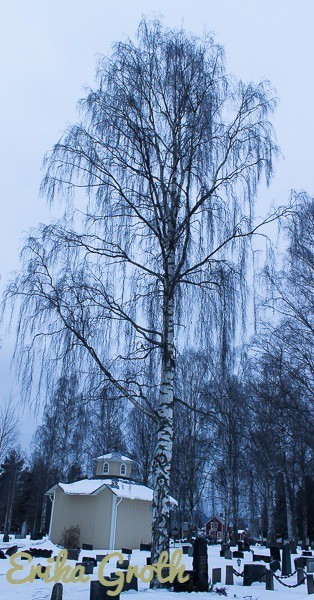
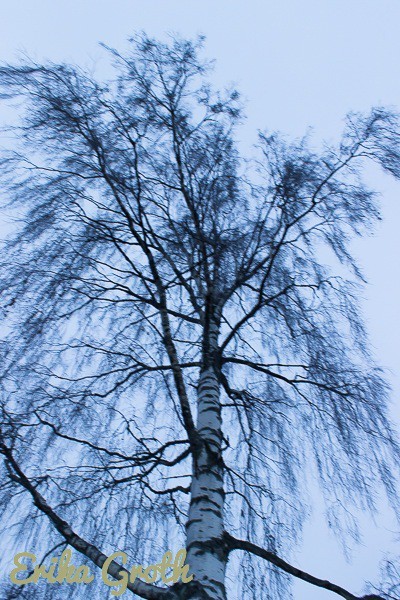
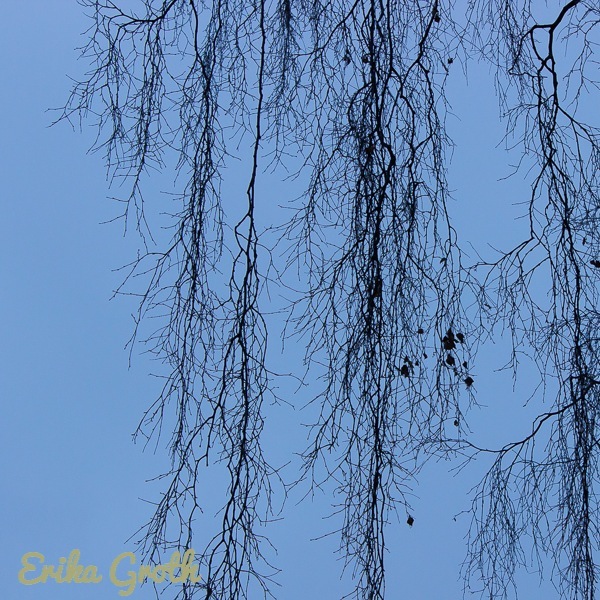
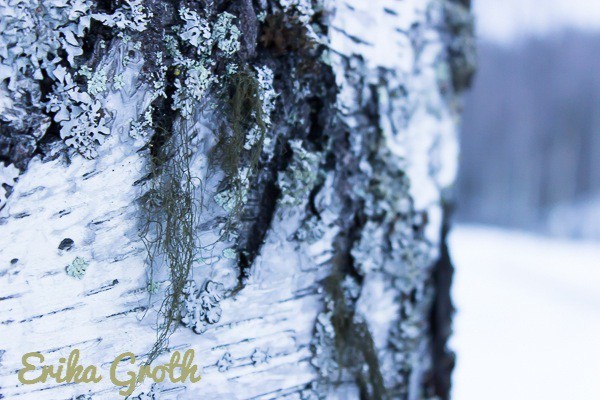
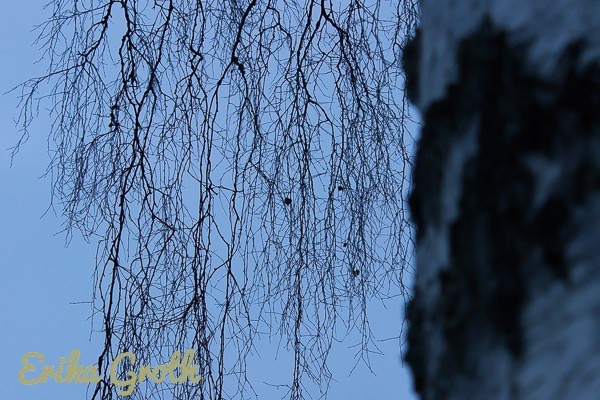 Fotona ovan är tagna 2016-01-03 i Älvsbyn.
Fotona ovan är tagna 2016-01-03 i Älvsbyn.
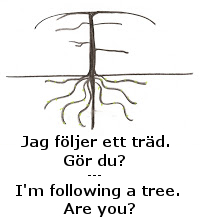 Kolla även in andra trädföljare på The Squirrelbasket (internationellt).
Kolla även in andra trädföljare på The Squirrelbasket (internationellt).
P.S. to non-Swedish readers:
Note that Ä (pronounced [ɛ:], [ɛ], [æ:] or [æ] depending on the word) and A ([ɑ:] or [a]) are different letters that represent two different vowels in Swedish. Ä is pronounced similar to the Swedish letter E ([e:] or [ɛ]) but not similar to the Swedish letter A. Ä and E are both soft vowels which are articulated in the front part of the mouth but A is a hard vowel that is articulated in the back part of the mouth. People from southern Sweden often pronounce E and Ä the same in almost all kinds of words whereas E and Ä are usually more clearly distinct in northern dialects. Ä and A should also not be mixed up with the Swedish letter Å (pronounced [o:] or [ɔ]) which is pronounced similar to O ([u:], [Ʊ], [o:] or [ɔ]) but not similar to Ö ([ø:], [œ], [ɶ:] or [ɶ]). In this You Tube video you can learn to pronounce the four Swedish hard vowels A, O, U, Å and the five Swedish soft vowels E, I, Y, Ä, Ö (in a kind of non-dialect style):

A Betula pendula tree grows in my yard. It’s a ”hanging” variety popular for landscaping, which we call weeping birch. I consider the leaves deeply-lobed but of course that’s relative. I look forward to seeing what your tree produces.
and I meant to say … I have to water it like crazy during dry parts of the season! Definitely not it’s native habitat here on the Laramie Plains.
That is a beautiful, delicate tree! And I like the lichen, too.
I will add the birch to your name on the main tree-following reference page.
I love birches but we have so many non-native examples planted in our parks here that I have given up trying to work out which particular species is which.
I very much look forward to seeing your tree as the days grow longer.
Happy New Year 🙂